
ALL DAY ON THE PLAINS AND RIVERS AROUND TRUJILLO, CÁSERES AND SANTA MARTA
WEATHER; a chilly start, with sunshine for most of the day but increasing amounts of cloud in the afternoon and an increase in wind strength. Top temp 22C
I told the group that these were our main target species for the day: Great & Little Bustards, Black-bellied & Pin-tailed Sandgrouse, Great Spotted Cuckoo, Roller, Spanish Imperial Eagle and Montagu’s Harrier. The ‘big eight’ plains species, guess how many we actually saw??? Read on to find out……………
We left the hotel at 7am with our breakfast in a box in the boot of the bus, we aimed to be on the plains as early as possible to give us the best chance of seeing our target birds.
We made two stops in Trujillo, the first stop was to look for a Scop’s Owl in a spot which as now become a well known site for them, in a horse chestnut tree in the centre of Trujillo. We failed to find the bird, the trees it was supposed to roost in was mega dense and so hard to see anything above 3-4 meters up. We gave up after a short while.
Next we drove around to the silos at the front of town where a huge colony of Lesser Kestrels have taken up residency. There are over 40 pairs breeding there now and we saw a lot of them. They were fantastic to watch as they went to and fro from the nest boxes provided for them.
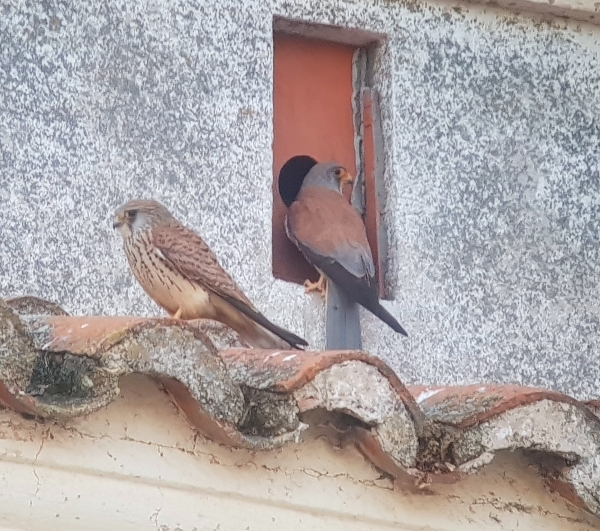
Lesser Kestrels at their nest box
We ate most of breakfast whilst watching the Kestrels, we then drove onto the plains just as the sun was rising. A quick stop at a road-side pool produced our first Black-winged Stilts, as well as Egyptian Geese, Gadwall and Mallards (both of the latter were being harassed by the geese). We saw a male Marsh Harrier flying nearby.
On the plains along the road to Santa Marta we made a couple of stops, the first produced very few species but I think it was worth it. We got to grips with the many larks on view; Crested, Thekla and Calandra larks. They were all singing and dashing about with dozens of Corn Buntings and Spanish Sparrows. We also logged Iberian Shrike, Eurasian & Iberian Magpies, Black Kite and White Storks.
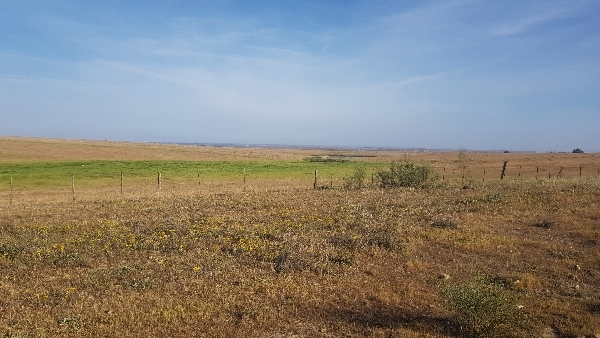
barren plains? I don't think so.
At the brow of the next hill we parked up and scanned the fields either side of the road, it seemed desolate out and so dry. Cattle roamed in the biggest fields and after ten minutes all we saw was larks, a Northern Wheatear, Hoopoe and Corn Buntings.
Then we picked out a Great Bustard, a female, and shortly afterwards we saw the male displaying right next to her. The magnificent male’s display seemed to be working as she began to get close and started following him, they disappeared over a ridge. Next up, was three Pin-tailed Sandgrouse, they landed noisily in the field behind us. Whilst scanning them we found another dozen, they all gave brief views as walked below a ridge, but everyone had in-the-scope sightings. They all flew off after about 15 minutes. Two of the big eight were in the bag.

if you look carefully you will see 3 Pin-tailed Sandgrouse
For the next hour we slowly crept along an unmarked track which gave us views of a huge expanse of land. We stopped by a pond and found Little Grebe, Mallard and Gadwall. At least three pairs of Pin-tailed Sandgrouse came down to drink, we had them all in flight but not on the ground.
Further along the track it was Mike that called out Little Bustard, wow! It was male and he was displaying. I got my scope onto a female and she seemed very interested, fanning out her tail in response. We watched them for quite a while before moving on. Three of eight, in the bag.
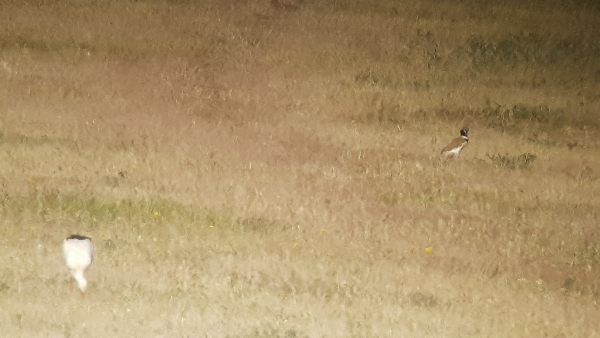
a White Stork and a Little Bustard
A couple of birders told us that had seen 6 Black-bellied Sandgrouse, they had flown up ahead of where we were going, so with a spring in our step we moved on. We had good close views of Bee-eaters, lots of raptors were in sky by now and it was warming up. Lorna then found a Montagu’s Harrier up ahead of us. At the same time a Black-bellied Sandgrouse flew across a field, circled round and came back. It landed out of sight of course over a distant ridge. Wow! That’s five of the big eight in the bag.
Whist waiting for the Black-bellied Sandgrouse to reappear we picked out a Spanish Imperial Eagle drifting over some distant trees. I knew that we were near a breeding site and the bird stayed in view for a good ten minutes. It was distant and hard for everyone to see it in the scope but it was number six of eight.
We drove into Santa Marta de Magasca to pick up lunch supplies and take a coffee break, but before long we were back on the road. We ate lunch sitting high on a bank above the Rio Magasca watching Crag Martins visiting theirs nest and picking out Grey and White Wagtails along the river. We saw Marsh frog, Spanish Pond Terrapins and a few butterflies.
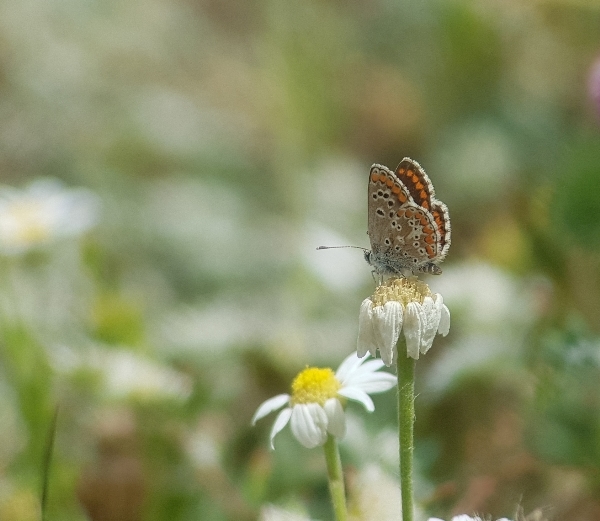
Southern Borwn Argus
Bove ten kilometers further along the road we came to Cáseres’s Plains where every telephone pole had a nest box strapped to it. They were intended for use by the European Roller but Common Kestrels, Jackdaws, Starlings and even Little Owls had taken over most of them. We saw about 6 Rollers, from the bus, because they fly off if you get out. They performed really well casing Jackdaws away and rival males. The colours were superb in the bright light. We watched a Little Owl too!
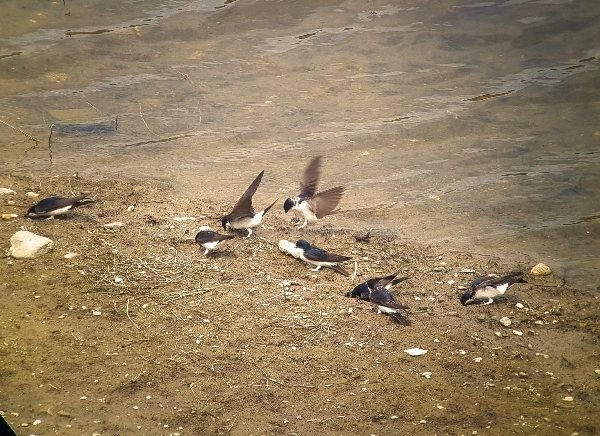
House Martins gathering mud
We now had seven of the big eight in the bag, now all we needed was the Great Spotted Cuckoo. So we drove into Cáseres and onto the Torrejon el Rubio road which took us to the Talavan Reservoir where I have seen the cuckoo many times. But before we got there we stopped at a bridge over the Rio Alomnte. There we had three atrget species, Alpine Swift, Blue Rock Thrush and Black Whetaear. We got all three of them within a few minutes, we also saw a few buuterflies and enjoyed watching huge numbers of House Martins collecting mud for nest contruction.

Western Dappled White
We logged Purple Heron, Yellow Wagtail, Coot, Moorhen, Gadwall, Black-winged Stilt from road bridge before we moved around to the dam. It was quite windy by now and the sun had disappeared behind the clouds.
I heard the Cuckoo calling and moved the group over ridge and from there we saw two of them!! One disappeared but Matt relocated the second bird and we ad prolonged views of it in a bush at the side of the reservoir. Shazam!! We had all eight in the bag!!
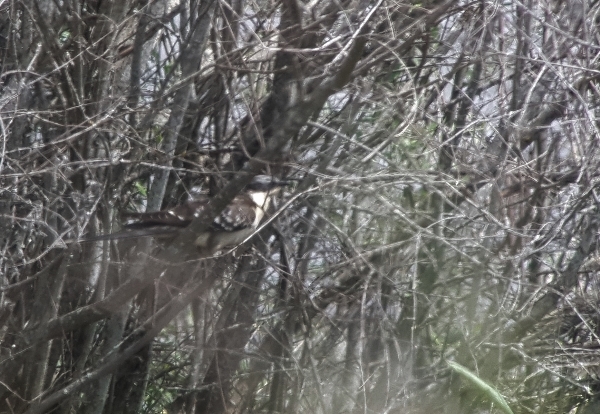
record shot of the Great Spotted Cuckoo
Our last stop was at a shallow pool called the Arroyo de Talavan, there Lorna located a calling Common Cuckoo, our first of the trip. Around the pool we saw Egyptian Geese, Black-winged Stilts, Common Sandpiper and Matt found us a single Ruff two pairs of Little Ringed Plovers and the best bird, a Wood Sandpiper.

Red-legged Partridge
What a great finale to a brilliant day out on the plains. Many other species were seen of course, we logged 80 species today.
